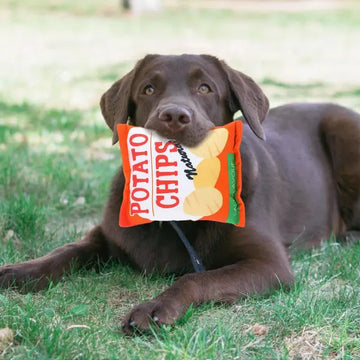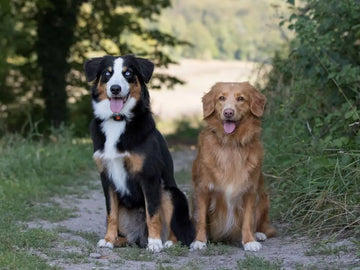Dog toys are more than just playful objects; they are an integral part of your pet's health and happiness. From keeping your furry friend engaged to supporting their physical and mental well-being, these toys are indispensable. However, amidst the joy they bring, dog toys can harbor a hidden downside: dirt, germs, and bacteria. This article explores why cleaning dog toys is essential, how to do it effectively, and the lasting benefits it offers to both your pet and your household.
The Importance of Clean Dog Toys for Your Pet’s Health
Pet toys, especially dog toys, come into direct contact with your dog’s mouth, paws, and sometimes even their food. Over time, these toys accumulate saliva, dirt, and debris, becoming breeding grounds for harmful bacteria and mold. If not cleaned regularly, these contaminants can lead to various health issues for your dog, including gum infections, digestive problems, and skin irritations.
For example, if you’ve recently purchased a Squeaky Snack Bag Dog Toy, it might quickly become your dog’s favorite chew item. While it provides hours of entertainment, the frequent chewing and slobbering can leave residue on its surface. Without cleaning, this fun squeaky toy could unintentionally become a health hazard.
How Dirty Toys Affect Your Home
Beyond affecting your dog’s health, dirty toys can impact your home environment as well. A damp, unclean toy left on the floor can leave stains on carpets or emit unpleasant odors. Additionally, bacteria and allergens carried by toys can spread throughout your home, potentially affecting your family members, especially children or those with allergies.
For instance, products like Rosewood Squeaky Dog Toys are designed to be durable and engaging, often becoming a staple in your dog’s daily routine. However, if not maintained properly, these toys can lose their original appeal and even spread germs, compromising the cleanliness of your living space.
Signs That Your Dog Toys Need Cleaning or Replacement
Recognizing when to clean or replace dog toys is crucial for maintaining a safe and hygienic environment. Some common signs include:
- Foul Odors: A lingering smell indicates bacterial buildup.
- Visible Dirt or Discoloration: Stains, grime, or discoloration show that the toy has accumulated dirt over time.
- Damage or Wear: Torn or cracked toys can trap bacteria and make cleaning difficult.
- Loss of Squeak or Functionality: If squeaky toys no longer produce sound, it might be due to dirt clogging the mechanism.
Regular inspections can help you decide when to clean a toy and when to replace it altogether.
How to Clean Dog Toys Safely
Cleaning your dog’s toys doesn’t have to be complicated, but it does require attention to the materials and design of the toy. Here’s how to clean common types of dog toys effectively:
1. Rubber and Plastic Toys
Rubber and plastic dog toys, such as chew toys and squeaky items, are among the easiest to clean. Use warm soapy water with a pet-safe detergent to scrub the surface. Rinse thoroughly to remove any soap residue, and allow the toy to air dry.
2. Fabric and Plush Toys
Soft toys can often be machine washed, but it’s essential to check the care label first. Place these toys in a laundry bag, use a gentle detergent, and wash on a delicate cycle with cold water. Avoid using fabric softeners, as they may leave a residue harmful to your pet.
3. Squeaky Toys
Toys with squeakers require extra care. Avoid submerging the squeaker mechanism in water, as it might lose its functionality. Instead, clean the surface with a damp cloth or sponge. For example, with a Squeaky Snack Bag Dog Toy, you can carefully wipe around the squeaker to maintain its sound while ensuring cleanliness.
4. DIY Natural Cleaning Solutions
For pet owners concerned about harsh chemicals, natural cleaning solutions work wonders. A mixture of white vinegar and water is an excellent option for disinfecting and removing odors from both hard and soft toys.
How Often Should You Clean Dog Toys?
The frequency of cleaning depends on how often the toys are used and where they are used. Here’s a general guideline:
- Daily Use: Clean every one to two weeks, especially for toys that come into frequent contact with saliva or food.
- Outdoor Use: Wash after each outdoor play session to remove dirt and bacteria.
- Interactive Toys: Clean puzzle toys and food-dispensing toys after every use to prevent food residue buildup.

Benefits of Regularly Cleaning Dog Toys
Keeping your dog’s toys clean comes with a host of benefits for both your pet and your household:
- Enhanced Durability: Proper maintenance extends the life of toys like Rosewood Squeaky Dog Toys, preserving their quality and usability.
- Improved Hygiene: Clean toys minimize the risk of infections, ensuring your dog’s well-being.
- Odor Control: Regular cleaning prevents bad smells from permeating your home.
- Peace of Mind: A clean environment promotes a happier, healthier bond between you and your furry friend.
Maintaining a Routine: Tips for Busy Pet Owners
Life can get busy, and it’s easy to overlook cleaning your dog’s toys. Here are some practical tips to help you stay on track:
- Create a Schedule: Set reminders on your phone for toy-cleaning days.
- Rotate Toys: Use a toy rotation system to ensure that only clean toys are in use at any given time.
- Use Quick-Clean Methods: Keep a damp cloth or pet-safe cleaning wipes handy for on-the-go cleanups.
- Involve Your Dog: Turn the cleaning process into a fun activity by engaging your dog in toy rotation or selection.
Building a Safe and Happy Environment for Your Pet
As a pet owner, your dog’s safety and happiness are your top priorities. Ensuring their toys are clean is a small but impactful way to show your love and care. Whether it’s a favorite squeaky toy or a durable rosewood squeaky dog toy, each item plays a significant role in your dog’s daily life. By maintaining these toys, you’re fostering a cleaner, safer, and more enjoyable environment for both your pet and your family.
Take a moment to inspect your dog’s toys today—maybe even clean one or two. After all, your furry friend relies on you to keep their playtime not only fun but also safe and hygienic. It’s these small acts of care that strengthen the bond between you and your dog, creating moments of joy that last a lifetime.









